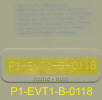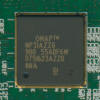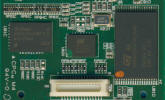
DATAMATH CALCULATOR MUSEUM
 |
DATAMATH CALCULATOR MUSEUM |
Texas Instruments Phoenix 1 (Engineering Validation Tests 1)
| Date of introduction: | (May 12, 2006) | Display technology: | LCD dot matrix 16-level greyscale |
| New price: | Display size: | 240 * 320 pixels | |
| Size: | 7.9" x 3.9" x 0.85" 200 x 100 x 22 mm3 |
||
| Weight: | 8.8 ounces, 250 grams | Serial No: | P1-EVT1-B-0118 |
| Batteries: | 4*AAA | Date of manufacture: | mth 02 year 2006 |
| AC-Adapter: | Origin of manufacture: | ||
| Precision: | 14 | Integrated circuits: | CPU: TI-OMAP NP31AZZG SDRAM: HYB18L256160 Flash: SST 39VF400A, ST NAND256W3A Display: Novatek NT7702H, 2*xxx |
| Memories: | |||
| Program steps: | 20M Bytes, 16M Bytes Flash ROM | Courtesy of: | Joerg Woerner |

![]()
 Texas Instruments filed already October 24, 2003 in
Texas Instruments filed already October 24, 2003 in

 The
Phoenix 1 obviously lacks a stylus and seems to trace back
to another root than the "PDA-based graphing calculator", a hype started
early in this millennium with the Hewlett Packard Xpander. This Windows CE based
calculator looked like a PDA with a 240 * 320 pixel gray-scale touch screen,
a small numeric keypad and the stylus. Hewlett Packard canceled the
project February 2001 with just a few prototypes left to the disappointed
market. Dismantling one of the prototypes revealed a design centered around a
Hitachi SH3 RISC-Processor, 8M Bytes of RAM and 16M Bytes of
The
Phoenix 1 obviously lacks a stylus and seems to trace back
to another root than the "PDA-based graphing calculator", a hype started
early in this millennium with the Hewlett Packard Xpander. This Windows CE based
calculator looked like a PDA with a 240 * 320 pixel gray-scale touch screen,
a small numeric keypad and the stylus. Hewlett Packard canceled the
project February 2001 with just a few prototypes left to the disappointed
market. Dismantling one of the prototypes revealed a design centered around a
Hitachi SH3 RISC-Processor, 8M Bytes of RAM and 16M Bytes of
Japanese calculator company Casio was more successful and
introduced in 2002 the ClassPad 300 with a 160 * 240 pixel gray-scale touch
screen supporting a lot of stylus based operation like drag-and-drop. This
design makes use of the Hitachi SH7291 - a SH3 based RISC-Processor, 0.5M Bytes of RAM and
4M Bytes Flash ROM.
The ClassPad 300 Plus introduced in 2005 makes use of a much improved display with higher contrast and better readability under low lighting conditions.
 This
early Phoenix 1 prototype, later known as TI-Nspire CAS+, with the serial number P1-EVT1-B-0118
was used for Engineering Validation Tests (EVT - learn more about the
Five Engineering Stages). At first glance
does it look very similar to the final TI-Nspire CAS device,
but we observe some differences with the TI-Nspire CAS
introduced in July 2007:
This
early Phoenix 1 prototype, later known as TI-Nspire CAS+, with the serial number P1-EVT1-B-0118
was used for Engineering Validation Tests (EVT - learn more about the
Five Engineering Stages). At first glance
does it look very similar to the final TI-Nspire CAS device,
but we observe some differences with the TI-Nspire CAS
introduced in July 2007:
• The color scheme is completely different
• The cursor control makes use of inner and outer keys
• Some function keys have different positions
Please notice that the evaluation of the Phoenix 1 led to multiple generations of TI-Nspire CAS+ Prototypes with different designs and color schemes and keyboard layout. Interesting to learn that these samples were labeled TI-Nspire CAS+ but still sported the "Phoenix" project name on the printed circuit boards (PCBs). Please notice this press release dated May 12, 2006 announcing the New Zealand introduction of the TI-nspire™ CAS+.
Don't miss the TI-Nspire+ manufactured in May 2006.
Architecture:

 Dismantling this
Phoenix 1 prototype reveals an internal design somewhere between the
PLT-SHH1 prototype based on the sophisticated POMAP1509E and the ZEVIO architecture
of the final TI-Nspire CAS. Learn more about the
Hardware Architecture of TI’s Graphing Calculators.
Dismantling this
Phoenix 1 prototype reveals an internal design somewhere between the
PLT-SHH1 prototype based on the sophisticated POMAP1509E and the ZEVIO architecture
of the final TI-Nspire CAS. Learn more about the
Hardware Architecture of TI’s Graphing Calculators.
 Processor:
The OMAP™ processor of the Phoenix 1 prototype is
labeled TI-OMAP NP31AZZG. We assume that this tiny chip is actually a
System-on-Chip based on the OMAP5912
architecture from Texas Instruments hosting a ARM9 32-bit RISC
processor clocked at 78 MHz and a TMS320C55xx Digital Signal Processor
core.
Processor:
The OMAP™ processor of the Phoenix 1 prototype is
labeled TI-OMAP NP31AZZG. We assume that this tiny chip is actually a
System-on-Chip based on the OMAP5912
architecture from Texas Instruments hosting a ARM9 32-bit RISC
processor clocked at 78 MHz and a TMS320C55xx Digital Signal Processor
core.
 Memory:
The Phoenix 1 prototype makes use of three different memory chips:
Memory:
The Phoenix 1 prototype makes use of three different memory chips:
•
NOR Flash-ROM
•
NAND Flash-ROM
•
SDRAM
The disassembled Phoenix 1 prototype (Manufactured February 2006) features one SST 39VF400A NOR Flash-ROM, manufactured by Silicon Storage Technology, Inc. with a 256k*16 bits organization and one ST NAND256W3A NAND Flash-ROM with 32M Bytes size.
The program and data memory of the disassembled Phoenix 1 consists of one Infinion HYB18L256160 SDRAM with 16M*16 bits capacity.
Please notice that all three memory chips are almost identical with the parts located in the released TI-Nspire CAS with the April 2007 manufacturing date. The only difference is the supply voltage, it was lowered from 3.3 volts to 1.8 volts.
![]() Display: The
Phoenix 1 uses a high-contrast display with a
resolution of 240 * 320 pixels, a huge improvement over the TI-89 Titanium with
100 * 160 pixels or the Voyage 200 with 128 * 240 pixels. The large 16-level
grey-scale displays includes a novel split screen capability with up to 4 views.
Display: The
Phoenix 1 uses a high-contrast display with a
resolution of 240 * 320 pixels, a huge improvement over the TI-89 Titanium with
100 * 160 pixels or the Voyage 200 with 128 * 240 pixels. The large 16-level
grey-scale displays includes a novel split screen capability with up to 4 views.
The driver circuit of the LC-Display is compromised of 2 column driver and one
row driver manufactured by Novatek, Taiwan. We located a NT7702H
row-driver as
bare chip mounted on a flexible piece of circuit board attached between the
display and a PCB and two unknown column drivers.
ROM-Versions:
• Phoenix 1 (Engineering Validation Tests P1-EVT1-B-0118)
U-Boot 1.1.2 (January 23, 2006)
Phoenix Built (February 14, 2006)
System Built (February 15, 2006)Information provided by Xavier Andréani.
•
Phoenix 1
Computer Link Software for Windows
t.b.d.
If you have additions to the above article please email: joerg@datamath.org.
© Joerg Woerner, January 4, 2012. No reprints without written permission.